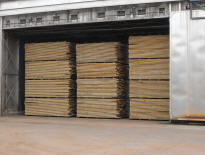In yesterday’s article, I was explaining lumber grade stamps to my son, Brent. One part of the stamp which is not in the five “required” designations (grading agency, producing mill, product grade, species and moisture content) was the “HT”.
HT designates the wood is heat treated lumber. Many countries require imported lumber to be heat-treated by law, as insect pests can live in raw (untreated) wood. The main pests which are targeted by heat treating are the pinewood nematode and the Asian long-horned beetle, although other pests are eliminated as well. By heat treating to eliminate these pests, crops and forests in other portions of the country and the world are protected from infestations which can arise from untreated wood being shipped in.
 In order for wood to be certified as heat treated lumber, it must have been heated to a temperature of at least 133 degrees Fahrenheit (56 degrees Celsius) for at least 30 minutes, at its core. This temperature and duration is considered adequate to destroy any itinerant pests or their eggs in the wood. Methods of heat treatment include kiln drying and chemical pressure impregnation (including steam heating, hot water heating and dry heating).
In order for wood to be certified as heat treated lumber, it must have been heated to a temperature of at least 133 degrees Fahrenheit (56 degrees Celsius) for at least 30 minutes, at its core. This temperature and duration is considered adequate to destroy any itinerant pests or their eggs in the wood. Methods of heat treatment include kiln drying and chemical pressure impregnation (including steam heating, hot water heating and dry heating).
Kiln Dried lumber and heat treatment are different. The purpose of kiln-dried lumber (“KD” as seen on lumber grade stamps) is to reduce the moisture content of the wood to 19% or less, this is a means to control warping, fungal growth and other quality features. The kilns (or ovens) the lumber is put into, do not necessarily reach the sustained temperatures of 133 degrees F. at the lumber core to qualify as heat-treated lumber. Many lumber mills are processing their lumber to meet the heat treatment requirements and have the “KD-HT” incorporated in their grade stamps.
Heat treating regulations were first introduced in 2001 by the European Union’s Emergency Measures, which established the 56/30 rule.
Mold is one of the greatest threats to heat treated lumber. Ironically, the chance of mold is increased when wood has been treated with heat. Mold can be combated by using anti-fungicide chemicals or by properly cooling heat-treated lumber.






